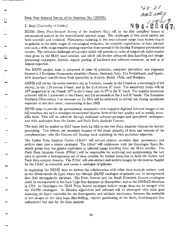
NASA Technical Reports Server (NTRS) 19940017994: Deep near-infrared survey of the Southern Sky (DENIS) PDF
Preview NASA Technical Reports Server (NTRS) 19940017994: Deep near-infrared survey of the Southern Sky (DENIS)
Deep Near-Infrared Survey of the Southern Sky (DENIS) _/z 2/2 N94 224 7 E. Deul (University of Leiden) DENIS (Deep Near-Infrared Survey of the Southern Sky) will be the first complete census of astronomical sources in the near-infrared spectral range. The challenges of this novel survey are both scientific and technical. Phenomena radiating in the near-infrared range from brown dwarfs r tO galaxies in the early stages of cosmological evolution, the scientific exploitation of data relevant ! over such a wide range requires pooling expertise from several of the leading European astronomical centers. The technical challenges of a project which will provide an order of magnitude more sources than given by the IRAS space mission, and which will involve advanced data-handling and image- w processing techniques, likewise require pooling of hardware and software resources, as wellas of human expertise. The DENIS project team is composed of some 40 scientists, computer specialists, and engineers located in 5 European Community countries (France, Germany, Italy, The Netherlands, and Spain), with important contributions from specialists in Austria, Brazil, Chile, and Hungary. L DENIS will survey the entire southern sky in 3 colours, namely in the I band at a wavelength of 0.8 micron, in the 1.25-micron J band, and in the 2.15-micron K_band. The sensitivity limits will be 18th magnitude in the I band, 16 th in the J band, and 14.5 th in the Kt band. The angular resolution achieved will be 1 arcsecond in the I band, and 3.0 arcseconds in the J and K_bands. The European Southern Observatory 1-m telescope on La Silla will be dedicated to survey use during operations expected to last four years, commencing in late 1993. DENIS aims to provide the astronomical community with complete digitized infrared images of the full southern sky and a catalogue of extracted objects, both of the best quality and in readily acces- sible form. This will be achieved through dedicated software packages and specialized catalogues, and with assistance from the Leiden and Paris Data Analysis Centers. The data will be mailed on DAT tapes from La Silla to the two Data Analysis Centers for further processing. Two centers are necessary because of the shear quantity of data and because of the complementary roles the Centers will develop, each exploiting its own particular expertise. The Leiden Data Analysis Center (LDAC) will extract objects, establish their parameters, and archive them into a source catalogue. The LDAC will collaborate with the Groningen Space Re- search group that has gained experience in infrared image handling from the IRAS satellite. The Paris Data Analysis Center (PDAC) will be responsible for archiving and preprocessing the raw data to provide a homogeneous set of data suitable for further reduction in both the Leiden and Paris data analysis streams. The PDAC will also extract and archive images for the sources flagged by the LDAC as extended, and create a catalogue of galaxies. w In exploiting the DENIS data we foresee the collaboration with other data analysis centers, such as the Observatoire de Lyon where the relevant DENIS catalogue of galaxies can be incorporated into their extragalactic database. The Point Sources and the Small Extended Sources catalogues could be incorporated in the Late Type Star database at Montpellier, and in the SIMBAD database at CDS. At Groningen the IRAS Point Source catalogue and/or image data can be merged with the DENIS catalogues. At Meudon algorithms and software will be developed with main goal assessing the limits reachable for the homogeneity and intrinsic consistency between the ensemble of the images in the data base (flat-fielding, relative positioning of the fields, bootstrapped flux calibration) but also for the data analysis. 36
